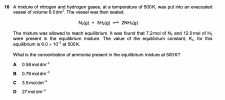- Messages
- 4
- Reaction score
- 0
- Points
- 11
Re: All Chemistry help here!! Stuck somewhere? Ask here!
A 20.0mL sample of 0.200M HBr solution is titrated with 0.200M NaOH solution. Calculate the pH of the
solution after the following volumes of base have been added:
15 mL
ANYBODY ????
HBr + NaOH -----> NaBr + H20
n=cv=0.02 x 0.2 = 4 x10^-3 moles of HBr
n of NaOH = cv= 0.015 x 0.2= 3 x 10^-3 moles.
1x10^-3 moles of HBr left. Assuming HBr is a strong acid, [H+] = 1x10^-3/0.02+0.015=0.0286 mol dm^-3
ph=-log[H+]=1.54
